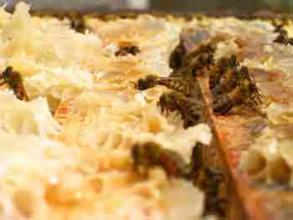Blog Post: Beekeepers in Alberta Know That It's All Relative

Albert Einstein once predicted that if bees disappeared from the earth, humans would meet the same fate within four years. Just south of Calgary, the Honey Meadows Farm works tirelessly to make sure this doesn’t happen. Honey Meadows produces over 300 metric tonnes of honey per year, making it one of Western Canada’s largest apiaries. To do this they adhere to a strict schedule, as the honey season only lasts from March to September due to the long Albertan winters. Last week, beekeeper Jon Zwiers gave me a hands-on tour of the first stages of producing this sweet treat.
Unlike cattle, the billions of Honey Meadows bees are not all kept in one big prairie field. Instead, groups of hives, called “bee yards,” are placed in the fields of surrounding farms. These industrious bees will fly up to three kilometers away in search of pollen, so the yards are spread out over a 100 kilometer radius to prevent competition for food in any one area. This meant that we had a lot of ground to cover in one day. With the summer workload well underway we set out first thing in the morning to deliver queen bees to their new hives. Our mission was to get to twenty yards by the end of the day, so after loading a truck with bee veils, queens and a smoker, we hit the road.
Previously Jon and his team had split some of the hives. This is done by taking several frames – bees, food and all – from a strong hive, and transferring them to an empty bee-box to make a new colony. This allows beekeepers to increase the number of hives they have and to prevent swarming. With each hive potentially producing up to 200 lbs of honey in a season, splitting is an important step for increasing the total honey production. In order to survive, the new hives each need a queen bee to run the show. Sometimes a new hive will begin to raise their own queen from an egg, while others will need to have a queen added to the hive. This is where my first assignment as a beekeeper comes in, as I hunkered down in the back of the truck next to 200 Hawaiian queens – aloha!
At the first yard, I triple checked the zippers on my veil and gloves and climbed out of the truck into the buzzing field, looking like a nervous astronaut taking her first steps on the moon. Unconcerned with the humming clouds of bees, Zwiers slid the lids off the hives and quickly blew smoke into them to lull the creatures into a docile acceptance of our presence. With the bees subdued, we reached into the hives to pull out frames, checking for queens or eggs on each one. In the queenless hives, Zwiers gently pried two frames apart so that I could squeeze a boxed queen in between. Each queen is delivered with a few worker bees in a two inch box, the end of which is covered with a sugary substance. Once in her new hive, the queen will eat through the sugar layer to be slowly integrated into her new home. In this line of work, Zwiers expects to get stung daily, but surprisingly after nine hours of rummaging around in a box full of bees I emerged unscathed! It must have been beginner’s luck.
The weather cooperated for my first day as an apiarist, but how do the bees survive in winter temperatures that can drop below -30º C? By August, Zwiers and his team will be racing against the seasons to get all the honey extracted before Old Man Winter returns. For the winter months the hives are wrapped in heavy tarps and the bees huddle together inside. This sounds like hibernation, but Zwiers says that they actually “never sleep, the constant beating of their wings in the hive keeps the temperature inside at a balmy 33˚C”. That said, only the strongest bees survive the winter and there is still a certain degree of colony loss incurred each year due to the frigid northern climate. This is quickly reversed in the busy summer months.
The skies full of bees at the Honey Meadows bee yards make Einstein’s predicted apocalypse seem impossible, but a dramatic global decrease in bees has repeatedly made headlines worldwide over the past few years. This phenomenon, commonly referred to as Colony Collapse Disorder, is not entirely understood by scientists, but is thought to be caused by a combination of factors including malnutrition, toxins in the environment and overworking bees for pollination. Luckily, Honey Meadows has not yet been a victim of this devastating occurrence. Zwiers attributes this to his team’s diligence in giving every hive the TLC it needs by working with the natural cycle of the bees to ensure they are prepared to adapt to Mother Nature’s ever-changing temperament. Einstein would be proud.
__________
Category:


































